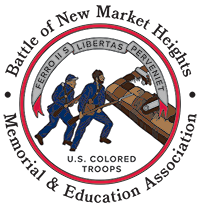Medal of Honor
On April 6, 1865 the Medal of Honor was awarded to African American soldiers for the very first time in American history (Sgt. William Carney of the 54th Massachusetts did not receive his Medal of Honor for gallantry in the 1863 assault on Battery Wagner until May of 1900).
The symbolic importance of what would become the nation’s highest honor being awarded to a class of people whom the Supreme Court had just eight years earlier deemed unworthy of any “rights which the white man was bound to respect” is truly astounding. Furthermore, the number of medals issued on that day – twelve (two more would follow in the postwar years) – is equally impressive.
All of these medals were issued for one momentous clash outside the gates of Richmond – the Battle of New Market Heights, fought on September 29, 1864. This battle involved black soldiers from the Army of the James successfully attacking a fortified position east of the Confederate capital.
Following the victory the Army of the James’s commanding general, Maj. Gen. Benjamin F. Butler, forwarded a list of men he thought deserving of the Medal of Honor to Lt. Gen. Ulysses S. Grant. The list was reviewed by Grant’s staff and then sent along to the War Department. For months, the matter was forgotten until finally, on April 6, 1865 the medals were issued to the following soldiers (unit and citation included):
1.) Pvt. William H. Barnes, 38th USCT: “among the very first to enter the rebel works, although himself previously wounded”
2.) 1st Sgt. Powhatan Beaty, 5th USCT: “in command, all their company officers being killed or wounded, and led them gallantly and meritoriously through the day”
3.) 1st Sgt. James Bronson, 5th USCT: “took command of his company, all the officers having been killed or wounded, and gallantly led it”
4.) Sgt. Maj. Christian Fleetwood, 4th USCT: “when two color bearers had been shot down, seized the national colors and bore them nobly through the fight”
5.) Pvt. James B. Gardiner, 36th USCT: “rushed in advance of his brigade, shot at a rebel officer, who was on the parapet cheering his men, and then ran him through with his bayonet”
6.) Sgt. Alfred Hilton (posthumously), 4th USCT: “the bearer of the national colors, when the color-sergeant with the regimental standard fell beside him, seized the standard, and struggled forward with both colors, until disabled by a severe wound at the enemy’s inner line of abatis, and when on the ground he showed that his thoughts were for the colors and not for himself”
7.) Sgt. Milton M. Holland, 5th USCT: “Took command of Company C, after all the officers had been killed or wounded, and gallantly led it”
8.) Cpl. Miles James, 36th USCT: “after having his arm so badly mutilated that immediate amputation was necessary, loaded and discharged his piece with one hand, and urged his men forward; this within thirty yards of the enemy’s works”
9.) 1st Sgt. Alexander Kelly, 6th USCT: “gallantly seized the colors, which had fallen near the enemy’s inner line of abatis, raised them, and rallied the men at a time of confusion and a place of the greatest possible danger”
10.) 1st Sgt. Robert Pinn, 5th USCT: “in command, all their company officers being killed or wounded, and led them gallantly and meritoriously through the day”
11.) 1st Sgt. Edward Ratcliff, 38th USCT: “thrown into command of his company by the death of the officer commanding, was the first enlisted man in the enemy’s works, leading his company with great gallantry”
12.) Pvt. Charles Veal, 4th USCT: “after two bearers of the regimental color had been shot down, seized it close to the enemy’s works and bore it through the remainder of the action”
In 1870, Sgt. Maj. Thomas R. Hawkins, 6th USCT was awarded a Medal of Honor for “rescue of regimental colors” at New Market Heights and four years after that Sgt. James H. Harris, 38th USCT received a Medal of Honor for “gallantry in the assault.” Furthermore, two white officer – Lt. Nathan H. Edgerton (6th USCT) and Lt. William H. Appleton (4th USCT) – received Medals of Honor for their participation in the assault, bringing the grand total of Medals of Honor awarded for New Market Heights to sixteen – fourteen to African American soldiers and two to white officers.

